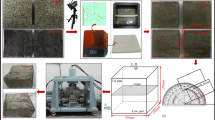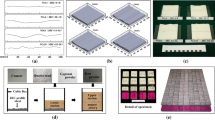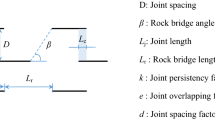Abstract
In this paper, a number of artificial rock specimens with two parallel (stepped and coplanar) non-persistent joints were subjected to direct shearing. The effects of bridge length (L), bridge angle (γ), joint roughness coefficient (JRC) and normal stress (σ n) on shear strength and cracking process of non-persistent jointed rock were studied extensively. The experimental program was designed based on Taguchi method, and the validity of the resulting data was assessed using analysis of variance. The results revealed that σ n and γ have the maximum and minimum effects on shear strength, respectively. Also, increase in L from 10 to 60 mm led to decrease in shear strength where high level of JRC profile and σ n led to the initiation of tensile cracks due to asperity interlocking. Such tensile cracks are known as “interlocking cracks” which normally initiate from the asperity and then propagate toward the specimen boundaries. Finally, the cracking process of specimens was classified into three categories, namely tensile cracking, shear cracking and combination of tension and shear or mixed mode tensile–shear cracking.

















Similar content being viewed by others
Abbreviations
- θ :
-
Joint angle with horizon
- γ :
-
Bridge angle
- L :
-
Bridge length
- JRC:
-
Joint roughness coefficient
- σ n :
-
Normal stress
- UCS:
-
Uniaxial compressive strength of intact specimen
- E :
-
Young’s modulus of intact specimen
- σ t :
-
Tensile strength of intact specimen
- τ :
-
Shear stress
- τ n :
-
Shear strength of non-persistent jointed specimen
- ANOVA:
-
Analysis of variance
- DoE:
-
Design of experiment
- OA:
-
Orthogonal array
References
Amadei B, Goodman RE (1981) A 3D constitutive relation for fractured rock masses. In: International symposium on the mechanical behaviour of structured media. Elsevier Scientific, pp 249–268
Asadizadeh M, Hossaini MF, Moosavi M, Mohammadi S (2016) A laboratory study on mix design to properly resemble a jointed brittle rock. Int J Min Geo Eng 50:201–210
Asadizadeh M, Moosavi M, Hossaini MF (2017) Investigation of the mechanical behaviour of non-persistent jointed blocks under uniaxial compression. Geomech Eng (accepted)
Asadollahi P, Invernizzi MA, Addotto S, Tonon F (2010) Experimental validation of modified Barton’s model for rock fractures. Rock Mech Rock Eng 43:597–613
Bahaaddini M, Sharrock G, Hebblewhite BK, Mitra R (2012) Statistical analysis of the effect of joint geometrical parameters on the mechanical properties of non-persistent jointed rock masses. In: 46th US rock mechanics geomechanics symposium (ARMA), Chicago, US, 24–27 June
Bahaaddini M, Sharrock G, Hebblewhite BK (2013a) Numerical direct shear tests to model the shear behaviour of rock joints. Comput Geotech 51:101–115
Bahaaddini M, Sharrock G, Hebblewhite BK (2013b) Numerical investigation of the effect of joint geometrical parameters on the mechanical properties of a non-persistent jointed rock mass under uniaxial compression. Comput Geotech 49:206–225
Bahaaddini M, Hagan PC, Mitra R, Hebblewhite BK (2014a) Scale effect on the shear behaviour of rock joints based on a numerical study. Eng Geol 181:212–223
Bahaaddini M, Saymontry J, Masoumi H, Hagan P (2014) Experimental study of the shear behavior of rock joints under constant normal load and constant normal stiffness conditions. In: 48th US rock mechanics/geomechanics symposium, ARMA, Minneapolis, US, 1–4 June, pp 1650–1656
Bahaaddini M, Hagan PC, Mitra R, Hebblewhite BK (2015) Parametric study of smooth joint parameters on the shear behaviour of rock joints. Rock Mech Rock Eng 48:923–940
Bahaaddini M, Hagan P, Mitra R, Hebblewhite BK (2016a) Numerical study of the mechanical behavior of nonpersistent jointed rock masses. Int J Geomech 16:04015035
Bahaaddini M, Hagan PC, Mitra R, Hebblewhite BK (2016b) Experimental and numerical study of asperity degradation in the direct shear test. Eng Geol 204:41–52
Bandis S (1980) Experimental studies of scale effects on shear strength, and deformation of rock joints. Ph.D. thesis, University of Leeds
Bandis SC (1990) Scale effects in the strength and deformability of rocks and rock joints. In: Proceedings of 1st international congress on scale effects in rock masses. Lisbon, pp 59–76
Barton N (1973) Review of a new shear-strength criterion for rock joints. Eng Geol 7:287–332
Barton N, Choubey V (1977) The shear strength of rock joints in theory and practice. Rock Mech Rock Eng 10:1–54
Brady BHG, Brown ET (2006) Rock mechanics: for underground mining. Springer, Berlin
Broek D (2012) Elementary engineering fracture mechanics. Springer, Berlin
Einstein HH, Veneziano D, Baecher GB, O’Reilly KJ (1983) The effect of discontinuity persistence on rock slope stability. Int J Rock Mech Min Sci 20:227–236
Gehle C, Kutter HK (2003) Breakage and shear behavior of intermittent rock joints. Int J Rock Mech Min Sci 40:687–700
Ghazvinian A, Sarfarazi V, Schubert W, Blumel M (2012) A study of the failure mechanism of planar non-persistent open joints using PFC2D. Rock Mech Rock Eng 45:677–693
Ghazvinian A, Nejati HR, Sarfarazi V, Hadei MR (2013) Mixed mode crack propagation in low brittle rock-like materials. Arab J Geosci 6:4435–4444
Grasselli G (2006) Manuel Rocha medal recipient shear strength of rock joints based on quantified surface description. Rock Mech Rock Eng 39:295–314
ISRM (2007) The complete suggested methods for rock characterization, testing and monitoring: 1974–2006 ISRM. In: Ulusay R, Hudson JA (eds) Suggested methods prepared by the commission on testing methods. Compilation arranged by the ISRM Turkish National Group, Kozan ofset, Ankara
Jade S, Sitharam T (2003) Characterization of strength and deformation of jointed rock mass based on statistical analysis. Int J Geomech 3:43–54
Kim BH, Cai M, Kaiser PK, Yang HS (2007) Estimation of block sizes for rock masses with non-persistent joints. Rock Mech Rock Eng 40:169–192
Kulatilake PHSW, Ucpirt H, Wang PS, Radberg G, Stephansson O (1992) Use of the distinct element method to perform stress analysis in rock with non-persistent joints and to study the effect of joint geometry parameters on the strength and deformability of rock masses. Rock Mech Rock Eng 25:253–274
Lajtai EZ (1969a) Shear strength of weakness planes in rock. Int J Rock Mech Min Sci 6:499–515
Lajtai EZ (1969b) Strength of discontinuous rocks in direct shear. Geotechnique 19:218–332
Li Y, Oh J, Mitra R, Hebblewhite BK (2016) Experimental studies on the mechanical behaviour of rock joints with various openings. Rock Mech Rock Eng 49:837–853
Li Y, Oh J, Mitra R, Canbulat I (2017) A fractal model for the shear behaviour of large-scale opened rock joints. Rock Mech Rock Eng 50:67–79
Mas Ivars D, Pierce ME, Darcel C, Reyes-Montes J, Potyondy DO, Young RP, Cundall PA (2011) The synthetic rock mass approach for jointed rock mass modelling. Int J Rock Mech Min Sci 48:219–244
Masoumi H (2013) Investigation into the mechanical behaviour of intact rock at different sizes. Ph.D. thesis, UNSW Australia
Masoumi H, Saydam S, Hagan PC (2016) Unified size-effect law for intact rock. Int J Geomech 16:04015059
Moosavi V, Talebi A, Shirmohammadi B (2014) Producing a landslide inventory map using pixel-based and object-oriented approaches optimized by Taguchi method. Geomorphology 204:646–656
Prudencio M, Van-Sint-Jan M (2007) Strength and failure modes of rock mass models with non-persistent joints. Int J Rock Mech Min Sci 44:890–902
Saeb S, Amadei B (1992) Modelling rock joints under shear and normal loading. Int J Rock Mech Min Sci 29:267–278
Sanei M, Faramarzi L, Goli S, Fahimifar A, Rahmati A, Mehinrad A (2015) Development of a new equation for joint roughness coefficient (JRC) with fractal dimension: a case study of Bakhtiary Dam site in Iran. Arab J Geosci 8:465–475
Sarfarazi V, Ghazvinian A, Schubert W (2014) Numerical simulation of the process of fracture of echelon rock joints. Rock Mech Rock Eng 47:1355–1371
Sarfarazi V, Ghazvinian A, Schubert W (2016) Numerical simulation of shear behaviour of non-persistent joints under low and high normal loads. Period Polytech Civ Eng 60:517–529
Savilahti T, Nordlund E, Stephansson O (1990) Shear box testing and modeling of joint bridge. In: Proceedings of international symposium on shear box testing and modeling of joint bridge rock joints, Norway, pp 295–300
Serrano A, Olalla C, Galindo RA (2014) Micromechanical basis for shear strength of rock discontinuities. Int J Rock Mech Min Sci 70:33–46
Sherpa MD, Hagan P, Masoumi H (2013) The effect of joint frequency on a discontinuous rock mass under experimental compressive strength testing conditions. In: 47th US rock mechanics geomechanics symposium (ARMA), San Francisco, US, pp 1088–1096
Taguchi G, Konishi S (1987) Taguchi methods orthogonal arrays and linear graphs: tools for quality engineering. American Supplier Institute, Beverly Hills
Vergara MR, Van Sint Jan M, Lorig L (2016) Numerical model for the study of the strength and failure modes of rock containing non-persistent joints. Rock Mech Rock Eng 49:1211–1226
Wang TT, Huang TH (2009) A constitutive model for the deformation of a rock mass containing sets of ubiquitous joints. Int J Rock Mech Min Sci 46:521–530
Wasantha PLP, Ranjith PG (2014) The Taguchi approach to the evaluation of the influence of different testing conditions on the mechanical properties of rock. Environ Earth Sci 72:79–89
Wong LNY, Einstein HH (2009) Crack coalescence in molded gypsum and Carrara marble: part 1. Macroscopic observations and interpretation. Rock Mech Rock Eng 42:475–511
Yang XX, Kulatilake PHSW, Chen X, Jing HW, Yang SQ (2016) Particle flow modeling of rock blocks with nonpersistent open joints under uniaxial compression. Int J Geomech 16:04016020
Zhang L (2010) Estimating the strength of jointed rock masses. Rock Mech Rock Eng 43:391–402
Author information
Authors and Affiliations
Corresponding author
Rights and permissions
About this article
Cite this article
Asadizadeh, M., Moosavi, M., Hossaini, M.F. et al. Shear Strength and Cracking Process of Non-persistent Jointed Rocks: An Extensive Experimental Investigation. Rock Mech Rock Eng 51, 415–428 (2018). https://doi.org/10.1007/s00603-017-1328-6
Received:
Accepted:
Published:
Issue Date:
DOI: https://doi.org/10.1007/s00603-017-1328-6




